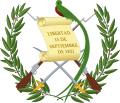| |||||||||||||||||
| |||||||||||||||||
| |||||||||||||||||
| This article is part of a series on |
| Politics of Guatemala |
|---|
 |
Presidential elections were held in Guatemala on 27 August 1920. The result was a victory for Carlos Herrera, who received 95% of the vote.
| |||||||||||||||||
| |||||||||||||||||
| |||||||||||||||||
| This article is part of a series on |
| Politics of Guatemala |
|---|
 |
Presidential elections were held in Guatemala on 27 August 1920. The result was a victory for Carlos Herrera, who received 95% of the vote.
| Candidate | Party | Votes | % | |
|---|---|---|---|---|
| Carlos Herrera | Unionist Party–Democratic Party | 246,976 | 94.59 | |
| José León Castillo | Republican Party | 7,948 | 3.04 | |
| Francisco Fuentes | West Republican Party–Constitutionalist Liberal Party | 5,983 | 2.29 | |
| 53 other candidates | 204 | 0.08 | ||
| Total | 261,111 | 100.00 | ||
| Source: Moore, Lloyd Jones | ||||